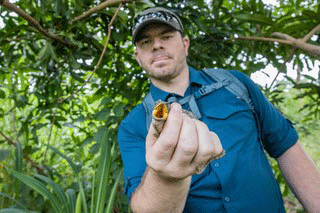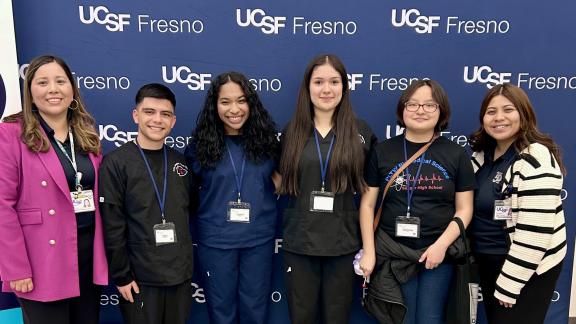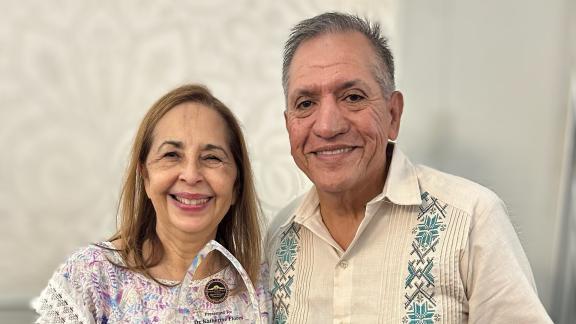 Ever since he was a little boy, reptiles have fascinated UCSF Fresno emergency physician and medical toxicologist Nicklaus Brandehoff, MD. His interest in herpetology has led to some interesting experiences, including working with venomous snakes before medical school at UC San Francisco School of Medicine.
Ever since he was a little boy, reptiles have fascinated UCSF Fresno emergency physician and medical toxicologist Nicklaus Brandehoff, MD. His interest in herpetology has led to some interesting experiences, including working with venomous snakes before medical school at UC San Francisco School of Medicine.
It’s not surprising that he determined early in his medical training that he wanted to practice snakebite medicine, and in Fresno, he has opportunity to do so. During a UCSF Fresno residency in emergency medicine, a medical toxicology fellow at the Rocky Mountain Poison and Drug Center, and now as a member of the UCSF Fresno emergency medicine and medical toxicology team at Community Regional Medical Center, Dr. Brandehoff is called to consult about snakebites regularly.
Venomous snakebites in Northern California are due to the Northern Pacific rattlesnakes that people stumble upon on hikes and walks in the foothills near Fresno. A rattlesnake bite can be serious, but recently, Dr. Brandehoff lent his expertise in snakebites a continent away in Guinea, West Africa, where the snakes including cobras, puff adders, rhinoceros vipers and mambas cause thousands of a bites every year.
Snakebites result in over 100,000 deaths worldwide annually, and Dr. Brandehoff is at the forefront of an effort to reverse tragic snakebite outcomes through research, clinical medicine, and education-based public health initiatives. He helped found Acelpius Snakebite Foundation (ASF), an international nonprofit organization led by experts in snakebite medicine who are combining their skills and knowledge to reduce deaths and maiming.
West Africa, including Guinea, has among the highest number of snakebites in the world, making it an important focus for the foundation’s efforts. This summer Dr. Brandehoff volunteered at Guinea’s only snakebite clinic.
“With the mamba bites out there, you can die within 30 minutes,” Dr. Brandehoff said. “They have saw scale vipers that you bleed out. And saw scale vipers probably account for more deaths in Africa than any snake there. With the cobras, you just become paralyzed within two to four hours and potentially die. They have spitting cobras, so even if you’re not near the snake they can hit you in the eye from about six feet away and cause you to go blind.”
Dr. Brandehoff spent three weeks at the snakebite clinic, which is in a converted house near Kindia about 60 miles (but a seven-hour drive due to poor infrastructure) from Conkary, the capitol of Guinea.
The clinic has limited medical resources but has made a significant difference in snakebite fatalities in Guinea since opening 20 years ago, Dr. Brandehoff said. “When they first started the clinic, they had about 35% of the people die. Now they have about 1%. You’re talking the difference between 100 to 200 deaths a year to about six or seven or maybe a few more.”
ASF has partnered with the Institut de Recherche et de Biologie Appliquée de Guinée, the research institute where the clinic is located. The foundation helps provide medical supplies, including antivenom; medical education inservices; and initiates public education campaigns about snakebites in the region.
Dr. Brandehoff has an interest in venomics and snake venom samples from Guinea are a rich source of material for research. “From a research standpoint, I think you could make a career just going to this place forever,” he said.
ASF is working with several Guinean medical professionals and local leaders about the importance of early antivenom administration. About 80% of snakebite victims delay coming to the clinic and first go to traditional healers, Dr. Brandehoff said.
ASF was fortunate to have approximately $20,000 of antivenom donated by Inosan to help treat envenomations. “The antivenom is nice because it covers all of the snakes out there except for Night adders and Stiletto snakes, which cause pain,” Dr. Brandehoff said. “The antivenom is really nice because it doesn’t need to be refrigerated. It reconstitutes in 30 seconds and you can push it instead of a drip,” he said. “You technically can give it to yourself in the bush if you got bit. We carry it with us.”
The austere environment in Guinea required Dr. Brandehoff to make accommodations.
“It’s wilderness medicine,” he said. (UCSF Fresno’s Wilderness Medicine program was a factor in his coming to UCSF Fresno for residency in emergency medicine). The snakebite clinic, for example, does not have ventilators to assist breathing for snakebite patients who have been paralyzed. Airway equipment, including respirator bag masks and face seals, were among the donated medical supplies that Dr. Brandehoff made sure to bring to the clinic.
“Some of these patients can be paralyzed for a couple of days or more, so you potentially are breathing for them (bagging by hand) for an undefined amount of time,” he said. And in some cases, family members are recruited to take over and squeeze the respirator bags to deliver air to the patient’s lungs, he said.
The rural clinic can be difficult to reach for some. “We don’t know how many people actually die before they even make it to the clinic,” Dr. Brandehoff said. “We had several patients take six or seven-hour motorbike rides to come in to the clinic.”
While in Guinea, Dr. Brandehoff and the other ASF volunteers met with the Ministry of Health and regional health directors and the Minister of Education to help solidify the partnership. They plan to return to Guinea and to the clinic every six months or so. For more information about AFS click here.
“The people were very welcoming and very happy to have us there,” Dr. Brandehoff said. “Our idea is to go back and provide education and help them get resources and in return they supply us with research opportunities, allowing us to branch out and hopefully decrease the mortality of snakebites there.”
Dr. Brandehoff’s expertise and interest in snakes, together with a commitment to reversing snakebite outcomes, extend UCSF Fresno’s commitment to service across the globe.





